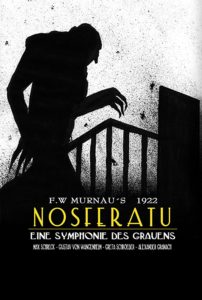Watch On Bruised Onion Studio YouTube Channel
Nosferatu (1922)
aka: Nosferatu: A Symphony of Horror
(German: Nosferatu, eine Symphonie des Grauens)
Silent German Expressionist Horror Film.
The film is an unauthorized and unofficial adaptation of Bram Stoker’s 1897 novel Dracula.
For copyright reasons, Bram Stoker’s Dracula novel was filmed with the names of the characters changed (Orlok for Dracula, for example) but otherwise the story remains the same: a young man goes on a trip to see a mysterious count in order to sell a house, leaving his bride behind, and finds that the creature he meets is not of this world.
This was the only Prana Film; the company declared bankruptcy after Stoker’s estate, sued for copyright infringement and won. Even with several details altered, Stoker’s heirs sued over the adaptation, and a court ruling ordered all copies of the film to be destroyed.
However, a few prints of Nosferatu survived, and the film came to be regarded as an influential masterpiece of cinema. The prints were duplicated over the years, kept alive by a cult following, making it an example of an early cult film.
The film was released in the United States on June 3, 1929, seven years after its original premiere in Germany.
It was ranked twenty-first in Empire magazine’s “The 100 Best Films of World Cinema” in 2010.
| Directed by | F. W. Murnau |
|---|---|
| Produced by |
|
| Screenplay by | Henrik Galeen |
| Based on | Dracula by Bram Stoker |
| Starring |
|
| Music by | Hans Erdmann |
| Cinematography |
|
|
Production
company |
Prana Film
|
| Distributed by | Film Arts Guild |
|
Release date
|
|
|
Running time
|
94 minutes |
| Country | Germany |
| Language |
|

